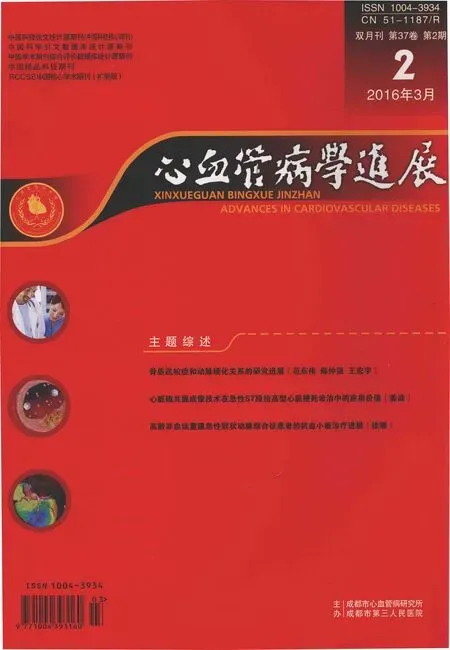左主干解剖形态与左冠状动脉粥样硬化研究新进展
许利冬 综述 李为民 审校
(哈尔滨医科大学附属第一医院心内科,黑龙江 哈尔滨150001)
左主干解剖形态与左冠状动脉粥样硬化研究新进展
许利冬综述李为民审校
(哈尔滨医科大学附属第一医院心内科,黑龙江 哈尔滨150001)
【摘要】左冠状动脉主干是指左冠状动脉发出后至分支前的节段,冠状动脉解剖形态是冠状动脉血流动力学与冠状动脉粥样硬化病变形成的一个关键性因素。以往的研究表明,因冠状动脉解剖形态造成的血流切应力变化在冠状动脉粥样硬化的发生和发展过程中起到重要作用,它的高低与血管壁厚度间存在负相关。在分叉处的外侧壁,血流切应力与粥样硬化斑块的形成密切相关。通过分析左冠状动脉主干的长度、分叉角度、直径等解剖因素,探讨左冠状动脉主干-长度、分叉角度、直径等潜在的血流动力学因素与左冠状动脉局部动脉粥样硬化斑块形成及左冠状动脉急性心肌梗死的相关性,了解左冠状动脉主干的长度、分叉角度、直径作为危险因素对左冠状动脉主干发生急性心肌梗死发生的价值,从而为冠心病患者预防急性心肌梗死的发生及相关高危人群的早期干预提供重要信息。
【关键词】左主干解剖形态;动脉粥样硬化;心肌梗死;
目前冠状动脉粥样硬化性心脏病(冠心病)是最主要的心血管疾病,急性心肌梗死是冠心病的一种严重表现类型,其具有发病急、并发症多、病死率高的特点,其中尤以左主干急性心肌梗死的严重程度为显著。急性心肌梗死是由冠状动脉血流急剧减少或中断所致的心肌缺血坏死。既往的研究显示其发生与遗传基因、性别、年龄、吸烟、高血压、高血脂、糖尿病以及新发现的致血栓致炎因子、高尿酸血症等相关[1-4]。随着研究的进一步深入,发现因冠状动脉自身的解剖特性引起的血流动力学改变,进而可引起冠状动脉粥样硬化及心肌梗死。目前,国外已有关于左主干解剖形态在左冠状动脉粥样硬化病变分布间关系的研究[5],但其相关性的研究仍未见报道。冠心病是多种因素共同作用的结果,但不同血管动脉粥样硬化的发生概率差别很大,动脉粥样硬化主要发生在大血管及血管分叉或发出分支处等血流变化明显的部位,而上述因素都不能完全解释动脉粥样硬化发生的局部性,因此推测,这种动脉粥样硬化斑块形成在解剖学上有着明显倾向,自然是与某种有选择定位作用的致病因素联系在一起。许多国内外学者研究证实,异常血液流动导致血流切应力改变在动脉硬化形成过程中起着重要作用[6]。血流切应力的高低、血流动力学形态的变化等亦对动脉粥样硬化的发生产生重要影响[7]。
1左冠状动脉主干解剖形态与左冠状动脉局部动脉粥样硬化
左冠状动脉主干起源于主动脉,然后分叉形成左前降支动脉和左回旋动脉。从组织学角度看,左冠状动脉主干是一个相当奇特的肌性动脉,因为它直接起源于主动脉壁缺乏外膜的缺口。左冠状动脉主干的中膜有着极其丰富的平滑肌细胞和弹性组织。左冠状动脉主干弹性组织比任何其他冠状动脉分支更为丰富,并且越向左冠状动脉主干远端发展,弹性组织越少,因此左冠状动脉主干的特定解剖特征,能够缓冲来自主动脉的冠状动脉血流量和减轻长期血流动力引起的下游分支血管损伤[8]。根据Gatopoulos报道,左冠状动脉主干的长度可能与动脉粥样硬化发病率和严重程度相关,而且罗德里格斯格拉尼洛还表明左冠状动脉主干的分叉角度及血流动力学变化可能是动脉粥样硬化的诱因[9]。根据以上相关潜在关系,左冠状动脉主干的解剖特点可能与左冠状动脉粥样硬化或急性心肌梗死的发生有关。
1.1左冠状动脉主干长度、直径与左冠状动脉局部动脉粥样硬化
左主干分支动脉粥样硬化病变的发展速度受左冠状动脉主干自身长度的影响[10]。Gazetopoulos等[11]认为短左冠状动脉主干是左冠状动脉粥样硬化斑块形成及发展过程中的先天性危险因素。Lewis和 Gotsman证明了短左冠状动脉主干与左冠状动脉粥样硬化斑块的关系 。Gazetopoulos等[11]的另一项研究表明短左冠状动脉主干比长左冠状动脉主干更容易出现下游分支动脉粥样硬化,且粥样硬化斑块出现较早,进展较快,同时也更加容易出现斑块破裂造成急性心肌梗死,血流量和血流速度与血管直径成正比,而与血管长度成反比。冠状动脉造影中校正的TIMI血流帧数(CTFC)能够反映下游分支血管的血流量及血流速度。在冠状动脉造影中,左冠状动脉主干长度与CTFC正相关。CTFC作为一种简单、直观的连续血流指数已经被证实与血流量及远端血流峰值平均速度负相关[12]。较短的左主干长度会增加其分支血管的血流速度与血流量,因此短左冠状动脉主干会减低左冠状动脉主干分支血流的切应力,低切应力则会诱导冠状动脉斑块形成[13]。值得注意的是,最近Cademartiri等[14]用冠状动脉64排CT评估左主干尺寸与斑块之间的关系,指出左冠状动脉主干长度和直径与斑块相关,特别是开口处的直径和角度与动脉粥样硬化斑块之间相关性更高,这些研究结果表明,左冠状动脉主干解剖特性在左冠状动脉粥样硬化的形成中扮演重要角色。
1.2左冠状动脉主干分叉角度与左冠状动脉局部动脉硬化
局部血流动力学在冠状动脉粥样硬化斑块的形成中起主要作用。冠状动脉分叉角度会影响冠状动脉血流的类型、流量和流速,从而影响斑块的形成[15]。早期的研究报告表明,动脉粥样硬化斑块倾向于出现在冠状动脉的特定位置,如近分叉、分叉等低血流切应力和流体分离的区域。之后的进一步研究证实了早期的研究,并进一步发现低血流切应力出现在血管分叉部位[16]。随着冠状动脉分叉角度的变化,冠状动脉血流的速度、角度及对内皮细胞冲击力发生变化,进而会引起内皮细胞受损,诱导动脉粥样硬化斑块形成。分叉角度增大,血流多呈现湍流状态,血流切应力较低,分叉角度较小,血流多呈现层流状态,稳定性较高。斑块多形成于左前降支和左冠状动脉主干分叉处的外侧管壁,呈偏心分布。随着冠状动脉分叉角度增大,其远端发生冠状动脉斑块的概率增加,冠状动脉分叉角度与冠状动脉分叉处斑块的发生率及分布相关[17]。血管内超声的相关研究同样也证明了动脉粥样硬化好发于低血流切应力的区域,例如血管的内部弯曲处和分叉口的外侧壁[18],原因是低血流切应力使流量导向的内皮细胞受损,从而造成黏附分子的增强表达和细胞连接的削弱,最终导致脂质和巨噬细胞的渗透增加和血管壁的增厚。同时通过血管内超声发现低切应力区域较震荡切应力区域易形成较大斑块,并且斑块所含脂质、平滑肌成分较多,胶原成分较少[19]。Ajayi 等[20]通过对170多例冠状动脉造影的图像分析后认为,斑块位于接近分叉处较分支远端存在斑块者左冠状动脉主干长度更长且分叉角度更大 。
2左冠状动脉主干解剖形态与急性心肌梗死
Dong等[21]连续性回顾分析1 825例患者的临床资料及冠状动脉造影图像,分组对比后表明左冠状动脉主干长度以及左冠状动脉主干与前降支分叉角度,对于预测冠心病患者发生急性心肌梗死是两个强有力并且独立的预测因素。短左冠状动脉主干和更大的左冠状动脉主干与前降支分叉角度的患者,其发生急性心肌梗死的危险性更大(敏感性为72%,特异性为86%)。目前,大多数研究多是通过多层计算机断层扫描,血管内超声等评价斑块易损性主要集中在斑块的分布、斑块负荷及形态以及血管重塑。然而血管自身的解剖特性是否会影响动脉粥样硬化斑块破裂的报道则相对较少。血流动力学是在血管解剖特性中最常被提到的因素,血流动力学是引起斑块破裂的重要危险因素,其中血流切应力起关键作用。动脉粥样硬化斑块破裂中血流切应力主要发挥两种作用:低切应力诱导稳定斑块向薄纤维帽过渡并促进易损斑块的形成;高切应力促进粥样硬化斑块的裂缝形成及斑块破裂[22]。Kawasaki等研究称左冠状动脉主干与左前降支角度增加,其分支血管的侧壁切应力相应增加可能会诱导斑块破裂。Gijsen 等冠状动脉分叉口是动脉粥样硬化和血管正性重构的好部位,两者均与血流切应力的降低有关,由于向心性斑块造成的管腔狭窄又导致了其远侧血流切应力的升高。他们的后续研究指出,对于已经形成的斑块,高血流切应力可能会动摇斑块,导致斑块破裂[23]。通常,血管狭窄的程度作为冠状动脉粥样硬化病变严重程度的指标,但与斑块的脆性相关性较差[24-25]。因为血管腔内的粥样硬化斑块总是处于血压和流量产生的确定机械负荷之下,当额外负荷增加超过纤维化斑块的强度时,斑块很容易发生破裂[26-28]。因此,应该在评估病变斑块的脆性和高危患者中考虑血管的形态和病变局部的机械特性对斑块的影响。
3展望
左冠状动脉主干自身的解剖特性对左冠状动脉、动脉粥样硬化斑块形成及分布产生重要影响,并在动脉粥样硬化性斑块破裂中起一定的作用。应在今后的临床工作中高度重视左冠状动脉主干自身的解剖特点。通过分析在冠心病患者的特殊左冠状动脉主干造影形态特征或者冠状动脉CT造影来预测左冠状动脉急性冠状动脉事件。患者的特殊解剖造影特点应该得到更积极和深入的关注。壁切应力及生物力学的风险因素的分析,为临床医生估计斑块易损性并确定适当的治疗和干预提供了附加的诊断依据。
[ 参 考 文 献 ]
[1]Lee SJ, Choi W, Seo E,et al.Association of Early Atherosclerosis with Vascular Wall Shear Stress in Hypercholesterolemic Zebrafish[J].PLoS One, 2015,10(11):1-16.
[2]Anssari-Benam A,Korakianitis T.Atherosclerotic plaques:is endothelial shear stress the only factor?[J].Med Hypotheses,2013,81(2):235-239.
[3]Bamberg F,Truong QA,Koenig W,et al.Differential associations between blood biomarkers of inflammation,oxidation,and lipid metabolism with varying forms of coronary atherosclerotic plaque as quantified by coronary CT angiography[J].Int J Cardiovasc Imaging,2012,28(1):183-192.
[4]Zhang H,Mo X,Hao Y,et al.Adiponectin levels and risk of coronary heart disease:a meta-analysis of prospective studies[J].Am J Med Sci,2013,345(6):455-461.
[5]Ajayi NO,Lazarus L,Vanker EA,et al.The impact of left main coronary artery morphology on the distribution of atherosclerotic lesions in its branches[J].Folia Morphol(Praha),2013,72(3):197-201.
[6]AlexyT, Pais E, Wenby RB,et al.Abnormal blood rheology and chronic low grade inflammation: possible risk factors for accelerated atherosclerosis and coronary artery disease in Lewis negative subjects[J].Atherosclerosis,2015,239(1):248-251.
[7]SoulisJV, Fytanidis DK, Seralidou KV,et al.Wall shear stress oscillation and its gradient in the normal left coronary artery tree bifurcations[J].Hippokratia,2014,18(1):12-16.
[8]Douglas AF, Christopher S, Amankulor N, et al.Extracranial carotid plaque length and parent vessel diameter significantly affect baseline ipsilateral intracranial blood flow[J].Neurosurgery,2011,69(4):767-773.
[9]Malvè M, Gharib AM, Yazdani SK,et al.Tortuosity of coronary bifurcation as a potential local risk factor for atherosclerosis:CFD steady state study based on in vivo dynamic CT measurements[J].Ann Biomed Eng,2015,43(1):82-93.
[10]Berry C, Noble S, Ibrahim R,et al.Remodeling is a more important determinant of lumen size than atheroma burden in left main coronary artery disease[J].Am Heart J,2010,160(1):188-194.
[11]Gazetopoulos N, Ioannidis PJ, Karydis C, et al.Short left coronary artery trunk as a risk factor in the development of coronary atherosclerosis.Pathological study[J].Br Heart J,1976,38:1160-1165.
[12]Jespersen L, Abildstrm SZ, Pea A, et al.Predictive value of the corrected TIMI frame count in patients with suspected angina pectoris but no obstructive coronary artery disease at angiography[J].Clin Res Cardiol,2014,103(5): 381-387.
[13]Choi G,Lee JM, Kim HJ.Coronary artery axial plaque stress and its relationship with lesion geometry:application of computational fluid dynamics to coronary CT angiography[J].JACC Cardiovasc Imaging,2015,8(10):1156-1166.
[14]Cademartiri F, Grutta LL, Malagò R,et al.Assessment of left main coronary artery atherosclerotic burden using 64-slice CT coronary angiography: correlation between dimensions and presence of plaques[J].Radiol Med,2009,114(3):358-369.
[15]Hasan M, Rubenstein DA, Yin W,et al.Effects of cyclic motion on coronary blood flow[J].J Biomech Eng,2013,135(12):121002-121010.
[16]Swillens A, Witte MD, Nordgaard H,et al.Effect of the degree of LAD stenosis on “competitive flow” and flow field characteristics in LIMA-to-LAD bypass surgery[J].Med Biol Eng Comput,2012,50(8):839-849.
[17]ChaichanaT, Sun Z, Jewkes J.Haemodynamic analysis of the effect of different types of plaques in the left coronary artery[J].Comput Med Imaging Graph,2013,37(3):197-206.
[18]Wentzel JJ, Gijsen FJ, Giessen R,et al.Positive remodeling at 3 year follow up is associated with plaque-free coronary wall segment at baseline:a serial IVUS study[J].Atherosclerosis,2014,236(1):82-90.
[19]宋翔,田树平,具海,等.左主干走行及分叉角度对左冠状动脉粥样硬化的影响[J].解放军医学院学报,2015,36(1):70-73.
[20]Ajayi NO, Lazarus L, Vanker EA,et al.The impact of left main coronary artery morphology on the distribution of atherosclerotic lesions in its branches[J].Folia Morphologica,2013,72(3):197-201.
[21]Dong ZF, Gong KZ, Xin P,et al.Predictive value of the angiographic anatomic characteristics of the left main coronary on acute myocardial infarction in patients with coronary atherosclerosis[J].J Invasive Cardiol,2013,25(9):449-454.
[22]An HJ, Lee WR, Kim KH,et al.Effects of Smad decoy ODN on shear stress-induced atherosclerotic ApoE-/-mouse[J].Int J Clin Exp Pathol,2015,8(4):3971-3978.
[23]Gijsen F, Giessen A, Steen A, et al.Shear stress and advanced atherosclerosis in human coronary arteries[J].J Biomech,2013,46(2):240-247.
[24]Tian J, Hou J, Xing L, et al.Significance of intraplaque neovascularisation for vulnerability:optical coherence tomography study[J].Heart,2012,98(20):1504-1509.
[25]Lansky AJ, Ng VG, Maehara A, et al.Gender and the extent of coronary atherosclerosis, plaque composition, and clinical outcomes in acute coronary syndromes[J].JACC Cardiovasc Imaging,2012,5(3 Suppl):S62-S72.
[26]Sadat U, Teng Z, Gillard JH.Biomechanical structural stresses of atherosclerotic plaques[J].Expert Rev Cardiovasc Ther,2010,8(10):1469-1481.
[27]Antoniadis AP, Giannopoulos AA, Wentzel JJ,et al.Impact of local flow haemodynamics on atherosclerosis in coronary artery bifurcations[J].EuroIntervention,2015,11(Suppl V):V18-22.
[28]Razavi SE, Omidi AA, Saghafi Zanjani M.Numerical investigation of blood flow in a deformable coronary bifurcation and non-planar branch[J].Bioimpacts, 2014,4(4):199-204.
New Progress Between Left Main Coronary Anatomy and Left Coronary Atherosclerosis
XU Lidong,LI Weimin
(DepartmentofCardiology,TheFirstAffiliatedHospitalofHarbinMedicalUniversity,Harbin150001,Heilongjiang,China)
【Abstract】Left main coronary artery refers to the left coronary artery segments before branching.Coronary anatomy is a key factor in coronary hemodynamics and coronary atherosclerotic lesion formation.Previous studies showed that shear stress changes caused from coronary anatomy plays an important role in the occurrence and development of coronary artery atherosclerosis in blood vessels between its high and low wall thickness and the presence of a negative correlation.In the outer wall of the bifurcation, shear stress is closely related to the formation of atherosclerotic plaque.The length of the left main, bifurcation angle, diameter and other anatomical factors is analyzed and the left main length, bifurcation angle, diameter and other potential hemodynamic factors and the left coronary artery partial formation of atherosclerotic plaques and the left coronary artery relevance are explored.Additionally, it is important to know the length of the left main, bifurcation angle and diameter as a risk factor for the left main coronary artery in and when acute myocardial infarction value occurs, so as to prevent coronary heart disease in patients with acute myocardial infarction and to provide important information and early intervention to patients and population with related risk.
【Key words】Left main anatomical form; Atherosclerosis; Myocardial infarction
收稿日期:2015-09-06修回日期:2015-11-27
【中图分类号】R543.3
【文献标志码】A【DOI】10.16806/j.cnki.issn.1004-3934.2016.02.000
作者简介:许利冬(1988—),住院医师,在读硕士,主要从事冠心病研究。Email:632076347@qq.com通信作者:李为民(1949—),主任医师,教授,主要从事冠心病、高血压病、心律失常等研究。Email:Liweimin_2009@163.com

